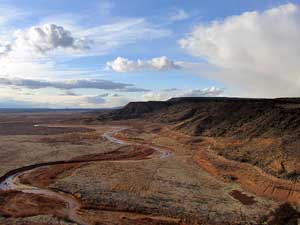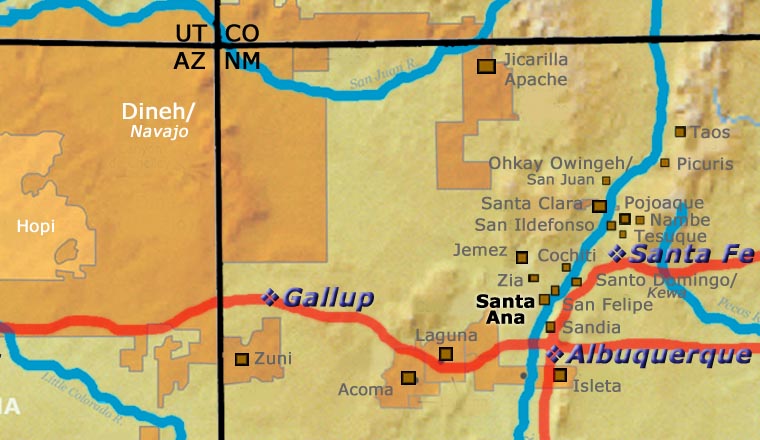
Santa Ana Pueblo

The Jemez River on Santa Ana Pueblo
The Santa Ana people have occupied the area around today's pueblo since the early 1500s. As Eastern Keres speakers they most likely arrived from the area of Frijoles Canyon at what is now Bandelier National Monument. Tamaya, their first pueblo in the new location, was located against a south-facing rocky mesa wall on the north side of the Jemez River. That location was well off the usual trade and travel routes in the area, making Tamaya one of the most secluded of all New Mexico pueblos.
The first Spanish arrived in the 1540s and the Santa Ana people resisted them until finally surrendering to Spanish rule in 1598. Spanish abuses led to the Pueblo Revolt of 1680 when the Pueblo peoples rose up together and forced the Spanish from Nuevo Mexico. Their freedom lasted for 12 years, then the Spanish returned in force, intent on staying. In the fighting after the Spanish return, the Santa Anans were forced to flee from their village and the Spanish looted and burned it, destroying many of the buildings. The tribe fled into the Jemez Mountains and finally gathered on Black Mesa before descending into the valley and surrendering to Spanish rule again in 1693.
The tribe began rebuilding their pueblo and moved to acquire more agricultural land along the Rio Grande. They supplemented their diet by hunting and gathering but slowly their tribal village industry economy shifted as more people became involved in the village agricultural economy and their trade changed until they were offering food in return for pottery from their Zia and Jemez neighbors. Those tribal members who still produced pottery in those days mostly emulated the creations of the Zias. Then the tribe moved downstream closer to the Rio Grande and new sources of clay and temper were found. Still, by the 1920's the Santa Ana pottery tradition was nearly extinct. Then Eudora Montoya (the last traditional Santa Ana potter) began holding classes to teach what she knew to other women in the tribe in the 1970's. Little pottery production, however, exists today.
100 West San Francisco Street, Santa Fe, New Mexico 87501
(505) 986-1234 - www.andreafisherpottery.com - All Rights Reserved
